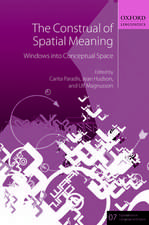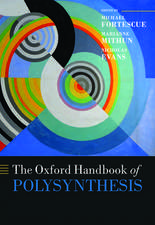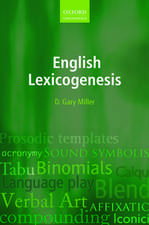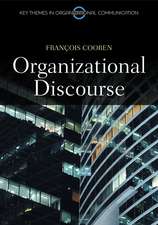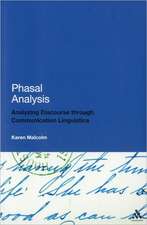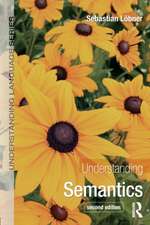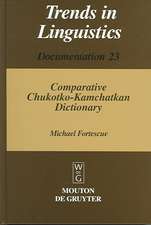A Neural Network Model of Lexical Organisation: Continuum Studies in Theoretical Linguistics
Autor Professor Michael Fortescueen Limba Engleză Paperback – 26 oct 2011
This is an engaging study of the mental lexicon: the way in which the form and meaning of words is stored by speakers of specific languages. Fortescue attempts to narrow the gap between the results of experimental neurology and the concerns of theoretical linguistics in the area of lexical semantics. The prime goal as regards linguistic theory is to show how matters of lexical organization can be analysed and discussed within a neurologically informed framework that is both adaptable and constrained.
It combines the perspectives of distributed network modelling and linguistic semantics, and draws upon the accruing evidence from neuroimaging studies as regards the cortical regions involved. It engages with a number of controversial current issues in both disciplines. This text is intended as a tool for linguists interested in psychological adequacy and the latest advances in Cognitive Science. It provides a principled means of distinguishing those semantic features required by a mental lexicon that have a direct bearing on grammar from those that do not. A Neural Network Model of Lexical Organisation is essential reading for researchers in neurolinguistics and lexical semantics.
| Toate formatele și edițiile | Preț | Express |
|---|---|---|
| Paperback (1) | 257.21 lei 6-8 săpt. | |
| Bloomsbury Publishing – 26 oct 2011 | 257.21 lei 6-8 săpt. | |
| Hardback (1) | 1005.18 lei 6-8 săpt. | |
| Bloomsbury Publishing – 9 iul 2009 | 1005.18 lei 6-8 săpt. |
Preț: 257.21 lei
Nou
Puncte Express: 386
Preț estimativ în valută:
49.21€ • 51.39$ • 40.64£
49.21€ • 51.39$ • 40.64£
Carte tipărită la comandă
Livrare economică 15-29 aprilie
Preluare comenzi: 021 569.72.76
Specificații
ISBN-13: 9781441117915
ISBN-10: 1441117911
Pagini: 248
Dimensiuni: 156 x 234 x 13 mm
Greutate: 0.35 kg
Editura: Bloomsbury Publishing
Colecția Continuum
Seria Continuum Studies in Theoretical Linguistics
Locul publicării:London, United Kingdom
ISBN-10: 1441117911
Pagini: 248
Dimensiuni: 156 x 234 x 13 mm
Greutate: 0.35 kg
Editura: Bloomsbury Publishing
Colecția Continuum
Seria Continuum Studies in Theoretical Linguistics
Locul publicării:London, United Kingdom
Caracteristici
Narrows the gap between the results of experimental neurology and the concerns of theoretical linguists.
Notă biografică
Michael Fortescue is Professor of General Linguistics in the Department of Scandinavian Studies and Linguistics of the University of Copenhagen, Denmark.
Cuprins
Part 1: The Basics
1. Introduction
1.1 The mental lexicon
1.2 The nature of the model
2. Some sample word templates
2.1 A noun template
2.2 Nouns versus verbs
2.3 Other parts of speech
2.4 A "derived" word
3. The production and comprehension of simple sentences
4. Expansion to a complex sentence
4.1 Some new word types
4.2 Production of a complex sentence - and an inference
5. Further dimensions of the model
5.1 Relating event structures
5.2 Nominalizations and abstract nouns
5.3 Some loose ends
Summary of Part 1
Part 2: Applications
6. Semantic fields and lexical categories
7. Compositionality
7.1 Nominal composition
7.2 Verbal decomposition
7.3 More on causal derivation
7.4 Complex word meaning: a test case for compositionality
8. Constructions
9. Polysemy
9.1 Polysemy and context
9.2 An excursion into metaphor and metonymy
10. Some further questions of qualia
11. Extensions to languages of different morphological type
Summary of Part 2
Part 3: Cognitive Justification of the Model
12. The interfacing of grammar and lexicon
12.1 Grammar templates
12.2 The realization of grammatical and semantic features by call trees
12.3 How call trees and combination matrixes might function
13. The neural representation of context
14. Acquisition
15. Prospective conclusions
15.1 The justification for separating affordance levels
15.2 Potential (dis)confirmation of the model
Appendix 1: The relationship to Burnod's neurological model
Appendix 2: Paradigmatic features of English words
Appendix 3: Sample derivations
List of templates
Graphic conventions as first introduced
References
Index
1. Introduction
1.1 The mental lexicon
1.2 The nature of the model
2. Some sample word templates
2.1 A noun template
2.2 Nouns versus verbs
2.3 Other parts of speech
2.4 A "derived" word
3. The production and comprehension of simple sentences
4. Expansion to a complex sentence
4.1 Some new word types
4.2 Production of a complex sentence - and an inference
5. Further dimensions of the model
5.1 Relating event structures
5.2 Nominalizations and abstract nouns
5.3 Some loose ends
Summary of Part 1
Part 2: Applications
6. Semantic fields and lexical categories
7. Compositionality
7.1 Nominal composition
7.2 Verbal decomposition
7.3 More on causal derivation
7.4 Complex word meaning: a test case for compositionality
8. Constructions
9. Polysemy
9.1 Polysemy and context
9.2 An excursion into metaphor and metonymy
10. Some further questions of qualia
11. Extensions to languages of different morphological type
Summary of Part 2
Part 3: Cognitive Justification of the Model
12. The interfacing of grammar and lexicon
12.1 Grammar templates
12.2 The realization of grammatical and semantic features by call trees
12.3 How call trees and combination matrixes might function
13. The neural representation of context
14. Acquisition
15. Prospective conclusions
15.1 The justification for separating affordance levels
15.2 Potential (dis)confirmation of the model
Appendix 1: The relationship to Burnod's neurological model
Appendix 2: Paradigmatic features of English words
Appendix 3: Sample derivations
List of templates
Graphic conventions as first introduced
References
Index
Recenzii
"Michael Fortescue sets forth "to provide a bridge between neurology and theoretical linguistics" and a patient reader can only conclude that he accomplishes this rather daunting, synthetic task exceptionally well. Neuroscientifically, the author is very well-informed, building on the work of established authorities such as Deacon and Pulvermüller, but mostly on the relatively less-known model of Yves Burnod. As an established cognitive-functional linguist, however, he far surpasses such work in linguistic coverage, rigor and theoretical sophistication. In the first part of the book, Fortescue develops a neurologically plausible model of the mental lexicon, distinguishing systematically between sensori(motor) affordances, and what he calls "mirco-functional affordances" (of key importance for grammar) and "macro-functional affordances" (related to pragmatics and context), and at the same time shows how they are integrated in speech production and comprehension. An important contribution is a three-dimensional graphic representational format, which may at first appear complicated, but is clearly worth the effort, since it possesses considerably more structure than alternative (connectionist) models, and therefore possibly for the first time shows how language could be neurally realized. In part 2, the model is applied to phenomena that have concerned linguists for quite some time: semantic fields, compositionality, grammatical constructions, polysemy (including metaphor and metonymy) and cross-linguistic variation (typology), both casting new light on them theoretically, and showing how they could be treated neuroscientifically. The third and final part is reserved for the most difficult issues: the relations between lexicon, grammar and context in language use and acquisition, and concludes by specifying predictions that can be experimentally tested. All this makes this book truly deserve the rather overused epithet "ground-breaking"". - Associate Professor Jordan Zlatev, Centre for Cognitive Semiotics, Lund University, Sweden
"Ambitious and thought-provoking: finally, a book that bridges the divide between neurology and theoretical linguistics. Professor Fortescue provides an important contribution to neurolinguistic modelling in the area of lexical organisation. This is set to be required reading for anyone interested in the nature of language and how it is represented in the brain."- Professor Vyvyan Evans, School of English and English Language, Bangor University, UK
"Ambitious and thought-provoking: finally, a book that bridges the divide between neurology and theoretical linguistics. Professor Fortescue provides an important contribution to neurolinguistic modelling in the area of lexical organisation. This is set to be required reading for anyone interested in the nature of language and how it is represented in the brain."- Professor Vyvyan Evans, School of English and English Language, Bangor University, UK








